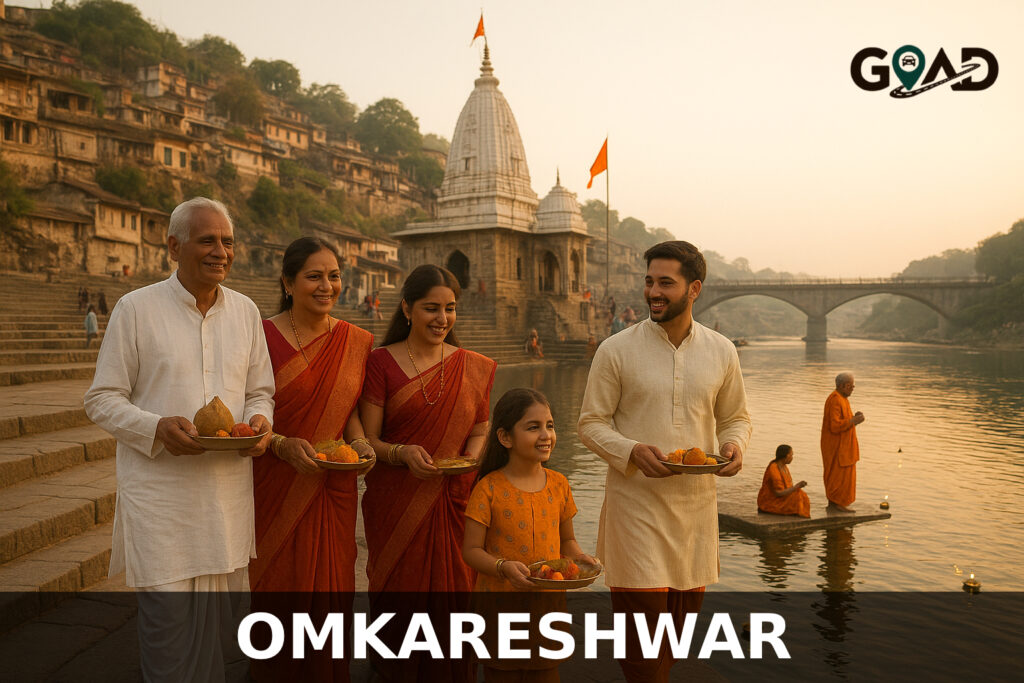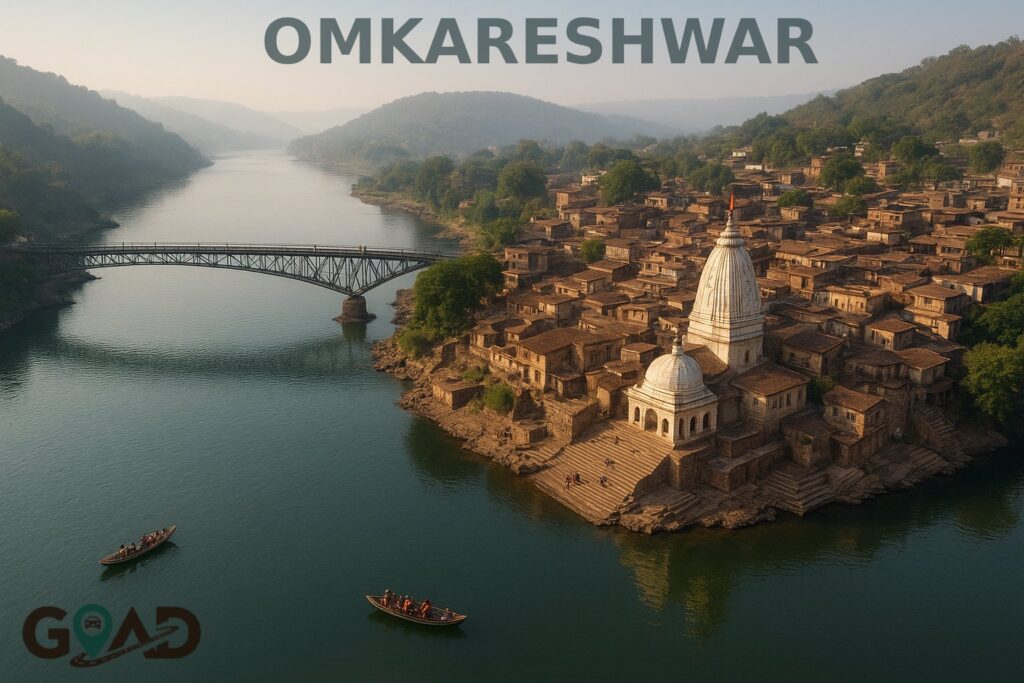Things to do in Omkareshwar: A Complete Guide for Pilgrims & Families

Omkareshwar isn’t just a dot on the map, it’s the kind of place that blends divinity, nature, and timeless charm into one unforgettable experience. Sitting quietly on the banks of the sacred Narmada River, this island shaped like the holy “ॐ” is more than a pilgrimage spot; it’s a journey into stories, rituals, and raw beauty.
From temple bells echoing through the ghats to boat rides that feel like time travel, Omkareshwar pulls you in with a calm that city life can’t offer. It’s where mornings start with chants floating over misty waters, afternoons are spent exploring narrow lanes lined with prasad shops, and evenings end with the soft glow of diyas reflecting on the river.
The town isn’t just for devotees, it’s for anyone looking to slow down, breathe, and feel connected to something bigger than themselves. And if you’re planning your first trip (or even a repeat one), this guide isn’t just going to tell you what to see; it’ll help you experience Omkareshwar like it’s meant to be felt.
Why Omkareshwar is Pilgrim's Top Destination?
Ancient stories breathe through every corner of Omkareshwar. One legend speaks of Vindhya Rishi, whose deep penance led him to craft a sacred lingam that so pleased Lord Shiva, the Lord chose to manifest here as both Omkareshwar and Mamleshwar, two forms of himself.
Another tale tells of King Mandhata, who performed intense austerities on this very island, infusing it with an enduring aura of devotion and divine favor. These myths aren’t just tales from the past, they still echo in the chants of pilgrims and in the quiet nods of the elders who’ve grown up with them.
The main temple reflects the graceful North Indian architectural style, shaped during the Peshwa era. Rising spires, ornate carvings, and a spacious mandap supported by sixty stone pillars span across five levels, each echoing centuries of worship.
Patronage from the Paramara rulers brought early prominence, later renewed by the Holkars’ reconstruction efforts. Today, the temple stands under the protection of the Archaeological Survey of India, ensuring that its historical beauty remains preserved for generations of pilgrims and travelers alike.
Top Things to do in Omkareshwar (2025 Edition)
Visit the Sacred Temples
Omkareshwar Jyotirlinga Temple
Right at the heart of it all is the Jyotirlinga. You can get there by boat, the kind that rocks gently with the river current, or by crossing the suspension Mamleshwar bridge, where the wind feels cooler and the temple slowly gets bigger in front of you.
Mamleshwar Temple
Across the river is Mamleshwar, the other half of the pilgrimage. It’s not as crowded as Omkareshwar, and that’s what makes it so good. The carvings are worn but still beautiful, like they’ve been holding stories for centuries.
Other Historic Shrines
- Siddhanath Temple: Up on Mandhata Hill, decorated with carved stone elephants that have been standing for 700 years.
- Gauri Somnath Temple: Built in the 11th century, this one’s layered with carvings from top to bottom.
- Kedareshwar Temple: Near the meeting point of the Narmada and Kaveri rivers, it has the same mountain-temple vibe as Kedarnath.
- Govinda Bhagavatpada Caves: Not just rock and stone, a place where one of India’s greatest spiritual thinkers began his path.
- Ekatma Dham: Dedicated to Advaita philosophy, it’s where you can just sit and let your thoughts untangle.
Be with the Narmada
Boat Ride & Jal Parikrama
Get on one of those small boats and you’ll see Omkareshwar from the water, temples leaning over the ghats, kids splashing around, women filling copper pots at the steps. If you’ve got the time, do the full 8 km Jal Parikrama around Mandhata Island. It’s slow, steady, and the river almost feels like it’s carrying you through a story.
Walking Parikrama
The land route is about 7–8 km. You’ll pass shrines tucked into corners, stray cows blocking your path, and spots where you just have to stop because the river is shining in that way it sometimes does.
Ghats & Rituals
The ghats are the living rooms of Omkareshwar.
- Omkar Ghat, Nagar Ghat, Abhay Ghat, each has its own personality, but Abhay Ghat is where things feel the most organized and peaceful.
- Mornings are for cold dips and chants that mix with the smell of incense. Evenings belong to the aarti, priests lifting brass lamps in arcs, flames flickering in the river breeze, and diyas floating away until they’re just little specks of light.
Culture & Local Life
Markets & Food
The lanes near the temples are stacked with stalls selling everything from rudraksha beads to brass idols. You’ll also get pulled in by the smell of fresh poha, jalebi sizzling in oil, and the soft, earthy taste of dal bafla. If you’ve never had sabudana khichdi in Madhya Pradesh, now’s the time.
Evenings by the River
Once the day’s crowds thin out, walk along the ghats. The air feels cooler, the river quieter, and you start hearing the little things, crickets, temple bells from far away, the soft lapping of water against stone.
Wildlife & Nearby Trips
The Omkareshwar Wildlife Sanctuary is nearby if you like birdwatching or just being surrounded by green. And if you’re in the mood for another river town, Maheshwar’s about an hour away, famous for its fort and the sarees that still carry stories in every weave.
How to Reach Omkareshwar from Indore?

Omkareshwar is about 77 km from Indore, and the journey is part of the charm.
By Road
- Duration: 2–2.5 hours via Khandwa Road.
- State-run buses are available, but for comfort, a taxi is recommended.
By Train
- Nearest station: Omkareshwar Road (12 km from the temple).
- You’ll need to take a taxi or shared auto from the station.
By Taxi Service
Booking an Indore to Omkareshwar cab is the most convenient option, it allows you to leave early, stop along the way, and return the same day if you wish. GoAD Cabs is one of the best taxi services in Indore, we provide personalized packages for every customer, making them feel like a family.
Best Time to Visit Omkareshwar
- October to March: Pleasant weather, perfect for sightseeing, parikrama, and photography.
- July to September: Monsoon brings greenery and an overflowing Narmada, making the scenery magical. However, some ghats may be slippery.
- April to June: Hot afternoons, but mornings and evenings are bearable. Keep hydrated and wear light cotton clothes.
Festivals
- Mahashivratri: The biggest celebration here. Expect massive crowds and grand decorations.
- Shravan Month: Devotees throng the temple, chanting and offering prayers.
Travel Tips for a Smooth Trip
Tip | Details |
Temple Timings & Dress | Most open 5 AM–9:30 PM; modest attire preferred; remove shoes before entry. |
Cash & Essentials | Carry small-change cash for sevā, offerings, and boat rides. |
Photography | Allowed in temple grounds, restricted in sanctums, observe signage. |
Boat Safety | Non-slip footwear, sun protection, and stable boarding steps are recommended. |
Stay Hydrated | Summer heat can be intense, carry water and travel early in the day. |
Local Etiquette | Respect rituals, offer silent prayers; photography during aarti may be inappropriate. |
Combine Nearby Visits | Add Maheshwar or a wildlife sanctuary to stretch your getaway. |
Wrapping Up!
Your trip to Omkareshwar will give you memories of temple bells, boat rides, river mists, and heartfelt peace. Whether you’re lighting a lamp for faith, admiring centuries-old carvings, or simply pausing by the Narmada, things to do in Omkareshwar fill both day and soul.
Booking GoAD Cabs for Indore to Omkareshwar taxi is a smart move, easy, flexible, and lets you soak in every moment without rushing. Here’s hoping you leave with a deeper calm, a lighter heart, and stories waiting to be shared. Har Har Mahadev!
